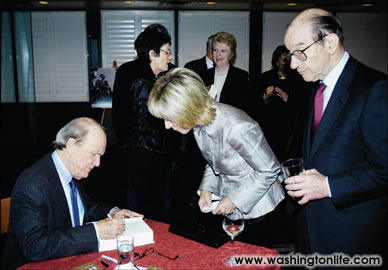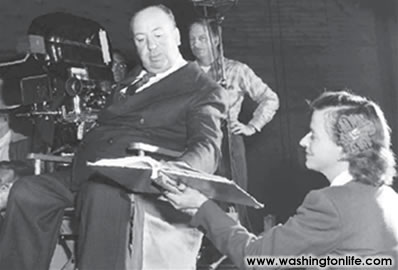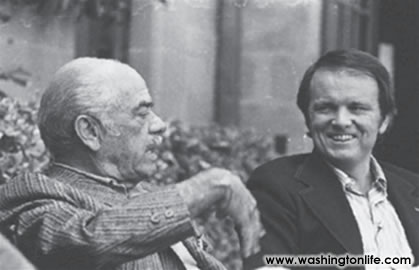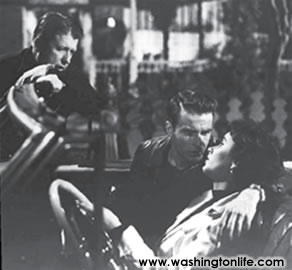POLLYWOODENTER THE GOLDEN AGE
|
||||||||||||||||
 |
WL: What followed the Golden Age and where
are we now?
GS: During the Golden Age most people went
to movies a couple of times a week. The only
way to see a film was in a darkened theater
with hundreds of other people. Then came
television, then VHS, then DVDs. The audience
became fragmented and the audiences that the
major studios seek to attract today are young
people sixteen to twenty-four years of age.
That defines the market for major films and
makes it more difficult to get funding for the
kinds of films that became classics during the
Golden Age. Creative filmmakers still make
wonderful films, but it is harder today to build
the rich careers that were achieved by the
filmmakers who were there during the years
when motion pictures were the dominant
form of entertainment.
WL: When you started this seminar series nearly 40
years ago, did you ever think they would become part
of film history?
GS: When we started the AFI conservatory in
1969, I was very caught up in the day-to-day
challenges of the work at hand. I was delighted
that we could attract these filmmakers to talk
with the students, but I never anticipated doing a
book thirty years later. With the passage of time,
the fact that we recorded these conversations
takes on greater meaning, because the filmmakers
are gone, but their ideas are still alive and are the
heart and soul of this book.
WL: The AFI has continued to have these conversations
with subsequent filmmakers, Altman, Scorsese, etc. Will
there be a sequel?
GS: Knopf has asked me to do a second book. I'm
discussing it with AFI. They control the seminars
and if they are willing to proceed, I will do a
sequel covering the next generation.
WL: How would you compare the atmospheres of
Washington and Hollywood?
GS: I left Hollywood in 1962 to work
with Edward R. Murrow who had come
to Washington to run the United States
Information Agency for President Kennedy.
I loved that opportunity for public service
and this led to my founding the American
Film Institute. I never got completely back
to Hollywood - I started living one of the
first bi-coastal lives. I soon discovered striking
similarities between the two cities and between
the pursuits of politics and movies - largerthan-
life ambition, public personalities, and
the opportunity for very visible success and
failure. Those common characteristics have
become accentuated over the years.
 |
WL: Your intro captures an era when the government
had enlightened views for adequately funding the arts.
Any chance of a return to that golden age?
GS: In ancient times there was the Age of
Pericles, which President Kennedy invoked when
he sought support for the arts, which was realized
in the National Endowment for the Arts. I think
we had our relatively brief Age of Pericles with
the Endowment, but I don't see the support in
Congress or the administration for that right now.
These initiatives are, I believe, cyclical.
WL: You talk in the book about working with your
father on Giant, Diary of Anne Frank, others. What
is it like working with your son Michael, who is
following in the family business?
GS: Two of the rich pleasures in my life have
been, first, working creatively with my father, and,
second, working with my son. Michael has made
his own way but we still find projects to work
together on. A creative life is both rewarding and
difficult. There's no safety net, you must live by
your own initiative and creativity. But when your
efforts succeed it is immensely satisfying, and you
can continue to do creative work for as long as
you have your wits about you.
WL: You are currently in rehearsals for a play about
Justice Thurgood Marshall starring James Earl Jones.
Could you tell me about it?
GS: We had a three-week run at the Westport
Country Playhouse in Connecticut to break
it in. James Earl had commitments that made
him unable to block out 16 consecutive weeks
for Broadway this spring so Bill Haber, the
producer, arranged this run at Westport - an
ideal way to launch the play. Thurgood Marshall
was a master of the storyteller's art. His stories
made his fellow Justices confront walks of life
we had never known. He was a man of heroic
imagination. He spent his life in public service
and made a dramatic difference in the life of his
country. It seemed to me that his story might
fascinate others as it has fascinated me.
 |
 |
WL: Other projects on the horizon?
GS: I am planning a film based on James Carroll's
memoir of his family, An American Requiem,
which won the National Book Award. It's an
extraordinary story of the 1960's. Jim's father,
General Joseph Carroll was the head of the
Defense Intelligence Agency during the Vietnam
War, and Jim became a Catholic priest, pleasing
his father greatly. The subtitle of Jim's book is,"God, my father and the war that came between
us." It's a moving story of a family in conflict over
a war and it has resonance today.
WL: Almost all the reviews of this book have singled
out your introduction, and the intros to each of the
conversations, many with delightful personal anecdotes.
Is there an autobiography that we might anticipate?
GS: I think I will do one, but I'm busy with
new projects and continuing projects like the
Kennedy Center Honors. It's hard to look back
when you're moving forward.
